What is Kidney Cancer Grade?
Kidney Cancer Grade refers to a description of how aggressive cancer cells look under the microscope. Sometimes patients confuse grade with stage because both use a 1 to 4 scale, however grade and stage are two distinct elements of a diagnosis.
Stage describes the size and spread of a tumor in the body. Grade describes how aggressive tumor cells look under a microscope after surgery or a biopsy and can give doctors an idea of how fast cells might grow.
Pathologists use a grading system for kidney cancer that was established by the International Society of Urological Pathology. This is often referred to as the WHO/ISUP grading system.
This page describes the four WHO/ISUP grades of kidney cancer.
Grade 1
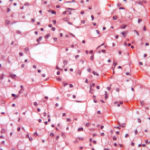
Grade 1 cells look more similar to normal cells. These tend to be less aggressive and less likely to spread. Grade 1 is the least common grade, seen in less than 10 percent of patients.
Grade 2
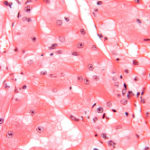
Grade 2 cells look less normal than grade 1 cells, have more prominent nucleoli and are more aggressive. Grade 2 is the most common grade for kidney cancer, representing roughly half of patients.
Grade 3
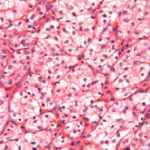
Grade 3 cells are higher grade cells. They grow more quickly, look very abnormal and indicate an increased likelihood that cancer might spread. About one-quarter of patients have grade 3 RCC.
Grade 4
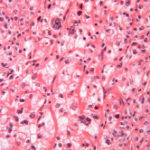
Grade 4 cells are high-grade, abnormal cells with large prominent nucleoli. They indicate an aggressive cancer that is more likely to spread. Between 15 and 20 percent of patients will have grade 4 RCC.
Sarcomatoid and Rhabdoid Features
Sarcomatoid dedifferentiation means that cancer cells have a “spindle” shaped appearance. Rhabdoid dedifferentiation means cancer cells have a “rod” shaped appearance. If one or both of these features are seen under the microscope, the pathology report may indicate the percentage of cells that have these characteristics. Presence of one or more of these features indicates a more aggressive cancer and automatically classifies the tumor as grade 4.
Sarcomatoid and Rhaboid features do not indicate a specific subtype of kidney cancer – these dedifferentiations can be found in all subtypes.
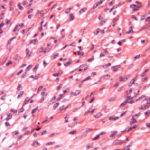
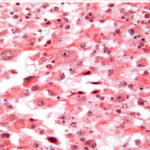
Frequently Asked Questions:
My pathology report has two different grades, what grade is my tumor?
Sometimes a pathology report might mention two different grades. In this case, the highest grade is the pathological grade for your cancer.
My oncologist had my pathology reread and now I’m being told that my grade is different than when I was first diagnosed. Did the first pathologist get it wrong? What does that mean?
It’s not uncommon for a second pathologist to look at your tumor tissue, whether it’s part of enrolling in a clinical trial, getting a second opinion or changing providers for any reason. This is usually done to verify the histology or type of cancer. But sometimes it can result in a different grade being assigned. It is important to note that the assessment of grade involves a human interpretation of features in the cells of the tumor. Therefore, it is not uncommon for grade to be subject to some human variability. There is also variability within the tumor tissue itself, so the grade could change based on the section of tumor that’s being looked at. These variations usually represent small shifts and rarely result in a change of recommendation for your care. But it can be unsettling for some patients when it happens.
Why does my pathology report say “Fuhrman” grade?
Until 2012, kidney cancer was graded using the Furhman grading system. Depending on when you were diagnosed, your pathology report might have a Furhman grade. Like WHO/ISUP, the Fuhrman grading system also uses a 1 to 4 scale indicating least aggressive to most aggressive. It’s similar to The WHO/ISUP grading system, however the College of American Pathologists Guidelines for RCC now recommend that pathologists use the newer WHO/ISUP scale.
I have chromophobe RCC. Why doesn’t my pathology report have a grade?
The WHO/ISUP grading system is validated in clear cell and papillary tumors and is used to describe most other subtypes of RCC. However in chromophobe, the WHO/ISUP grading system hasn’t been shown to be a valid prognostic tool. Although different grading systems have been proposed for chromophobe RCC, to date, none have been internationally accepted for use in clinical practice.
